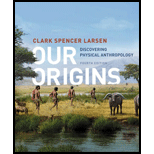
Concept explainers
Introduction: The genus Homo comprises modern humans as well as their close relatives. This genus is defined by certain behavioral as well as physical characteristics such as the small face, small jaws, and large brain.
Answer to Problem 1SQ
Correct answer: Option d) short legs relative to arms
Explanation of Solution
Reasons for the correct answer:
Option d) is given as “short legs relative to arms”.
Most of the anatomical characteristics differ between early australopithecine species and Homo habilis. The early australopithecines had a huge chewing complex and small brain. But the chewing complex of Homo habilis was smaller and the brain was large. The legs of Homo habilis were short relative to their arms and this feature was similar to the early australopithecine species.
Hence option d) is correct.
Reasons for the incorrect answers:
Option a) is given as “a small brain”. The early australopithecines had a smaller brain but the brain of Homo habilis was larger. Hence, option a) is incorrect.
Option b) is given as “a large chewing complex”. The early australopithecines had a huge chewing complex but the chewing complex of Homo habilis was smaller. Hence, option b) is incorrect.
Option c) is given as “a large face and large jaws”. The anatomical characteristics such as large jaws and large faces were found in early australopithecines whereas Homo habilis has face and jaws smaller than early australopithecines. Hence, option c) is incorrect.
Therefore, options a), b), and c) are incorrect.
Therefore, the anatomical characteristic that was similar between the earliest australopithecine species and the Homo habilis was legs that are shorter when compared to arms.
Want to see more full solutions like this?
- The defining trait of hominins is __________. a. tool use b. bipedalism c. a big brain d. endothermyarrow_forwardDescribe when did the different species of Homo appear? Differentiate and elaborate on how their cultures differ.arrow_forwardWhich is NOT true about Homo habilis: A) considered the first tool maker B) had a smaller brain the australopiths C) associated with the Oldowan tool industry D) was bipedalarrow_forward
- Explain how larger Horns in the males of dung beetles could have evolved?arrow_forwardWhat is one anatomical difference between Australopithecines and other early hominins, such as Ardi? A. There were no anatomical differences between Ardi and the Australopithecines. B. Ardi had a divergent big toe while the Australopithecines had non-divergent big toes. C. Australopithecines had more facial prognathism than Ardi. D. Australopithecines had larger canines than Ardi.arrow_forwardCompare and contrast Neandertals and Cro-Magnons.arrow_forward
- Which is NOT true about Hardrocodium?A) lived around 195 million years ago B) had a large brain compared to its skull size C) is considered a mammal-like reptile D) had large olfactory bulbs (enhanced sense of smell)arrow_forwardEvaluate how paleo anthropologist are able to reconstruct diet, locomotion, and behavior about once living hominins.Please use a specific fossils site from a species on how we reduce information about past homininsarrow_forwardBased on the available evidence, which is NOT true about the australopiths: A) had small, chimp-sized brains B) made stone tools C) were bipedal D) were partly arborealarrow_forward
- Why are plesiadapiforms most likely the earliest primate ancestors? A. They do not have a postorbital bar or plate B. Their eyes are forward-facing C. They have grasping fingers D. They have clawsarrow_forwardWhich species has the least robust brown ridges? A. Homo rudolfensis B. Homo habilis C. Australopithecus afarensis D. Homo erectusarrow_forwardHow can you reply to a discussion about animals with special adaptations?arrow_forward

 Biology (MindTap Course List)BiologyISBN:9781337392938Author:Eldra Solomon, Charles Martin, Diana W. Martin, Linda R. BergPublisher:Cengage Learning
Biology (MindTap Course List)BiologyISBN:9781337392938Author:Eldra Solomon, Charles Martin, Diana W. Martin, Linda R. BergPublisher:Cengage Learning Concepts of BiologyBiologyISBN:9781938168116Author:Samantha Fowler, Rebecca Roush, James WisePublisher:OpenStax College
Concepts of BiologyBiologyISBN:9781938168116Author:Samantha Fowler, Rebecca Roush, James WisePublisher:OpenStax College Human Biology (MindTap Course List)BiologyISBN:9781305112100Author:Cecie Starr, Beverly McMillanPublisher:Cengage Learning
Human Biology (MindTap Course List)BiologyISBN:9781305112100Author:Cecie Starr, Beverly McMillanPublisher:Cengage Learning



